#Askthenurse
Text
Ask the Nurse: Vaccines
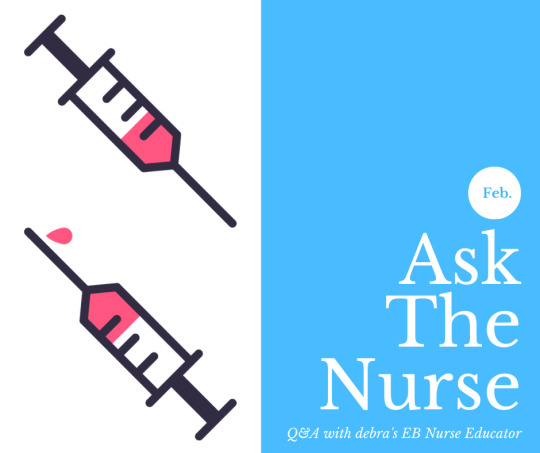
Each month, debra of America’s “Ask the Nurse” series will highlight a commonly asked question received by our Nurse Educator, Emily Griffith, BSN, RN. This month’s post focuses on Vaccines. Let’s get started!
Question: Is it safe to receive vaccines in EB and are there any precautions we should take?
Answer: Vaccinations during childhood and adulthood provide important defense against serious illnesses. Vaccines allow our body’s immune system to safely develop antibodies/immunity to diseases and reduce risk of these illnesses. Routine vaccinations in EB may be given at the appropriate, scheduled times as directed by your physician. You or your child may experience a mild reaction to some vaccinations, which includes a slight fever (under 102 degrees F), soreness and/or redness at the injection site. These symptoms can typically last up to 1 to 2 days and should be discussed with your healthcare provider. When receiving a vaccine injection, remind your healthcare worker to gently dab the area with alcohol to avoid any friction from cleansing the site. The injection should be placed at the appropriate site where there is intact skin. Following the injection there should be no vigorous rubbing or massaging, just gentle pressure with an EB-safe dressing to cover the site.
For more information regarding vaccines, please discuss with your healthcare provider. You can also refer to the CDC for more info on “Understanding How Vaccines Work” here.
Click here to watch Dr. Amy Paller’s video presentation on COVID-19 & EB on EBconnect.org.
To read more commonly asked questions, click here.
If you have an EB care-related question for our EB Nurse Educator, please email: [email protected] or call toll-free at 866-DEBRA-76 (866-332-7276).
*The information provided herein is intended to educate the reader about certain medical conditions and certain possible treatments. It is not a substitute for examination, diagnosis, and medical care provided by a licensed and qualified health professional. If you believe you, your child, or someone you know, suffer from conditions described herein, please see your healthcare provider. Do not attempt to treat yourself, your child, or anyone else without proper medical supervision.
3 notes
·
View notes
Photo

Paternity DNA Questions? Ask the Nurse.. [email protected] #dna #askthenurse#beaufortsc #loveblufftonsc #rochester #charlestonsc. 855.521.1362 https://www.instagram.com/p/B0KAE8xAn9c/?igshid=1u0tf0wdjohl0
0 notes
Text
Ask the Nurse: Mental Health
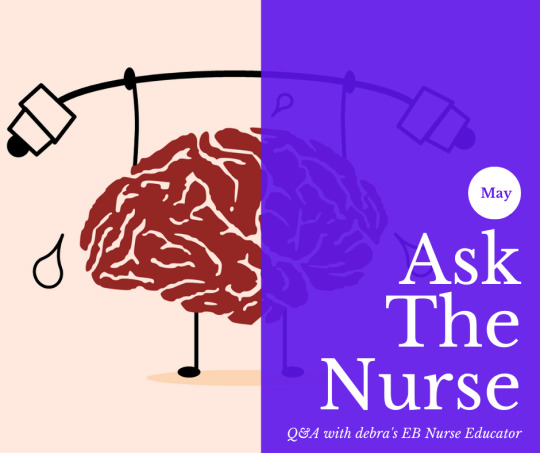
Each month, debra of America’s “Ask the Nurse” series will highlight a commonly asked question received by our Nurse Educator, Emily Griffith, BSN, RN. This month’s post focuses on Mental Health. Let’s get started!
Question: My child screams, cries and will not stay still when it is time to do wound care. Is this something they will outgrow or is there anything I can do to help?
Answer: Children of all ages can experience anxiety and stress around wound care, bathing, and dressing changes because these events may be painful for them. The child may also experience anticipatory anxiety where memories of painful events such as wound care leads to worry and fear of future dressing changes. As a caregiver to a child with EB, you can help your child by promoting positive coping skills and a comfortable environment around stressful events. This can be done with aromatherapy, music, distraction, breathing exercises, or positive mental imagery.
Infants feel comfort when they feel secure and warm, so being sure the room is not too cold and swaddling them while exposing one extremity at a time for wound care. Toddlers and school age children want to have some sense of control. Keeping to a routine so they know when to expect dressing changes, explaining in an age-appropriate way how wound care will take place and allowing the child to actively participate can help them cope. This may be holding a bandage and passing it to the caregiver when ready or picking a show to watch during care. After the dressing change, give the child positive affirmation on what they did well.
For more information on coping skills and tips for caregivers, check out Dr. Mark Popenhagen’s (Phoenix Children's Hospital) video talk on EBconnect.org.
To read more commonly asked questions, click here.
If you have an EB care-related question for our EB Nurse Educator, please email: [email protected] or call toll-free at 866-DEBRA-76 (866-332-7276).
*The information provided herein is intended to educate the reader about certain medical conditions and certain possible treatments. It is not a substitute for examination, diagnosis, and medical care provided by a licensed and qualified health professional. If you believe you, your child, or someone you know, suffer from conditions described herein, please see your healthcare provider. Do not attempt to treat yourself, your child, or anyone else without proper medical supervision.
1 note
·
View note
Text
Ask the Nurse: Bathing
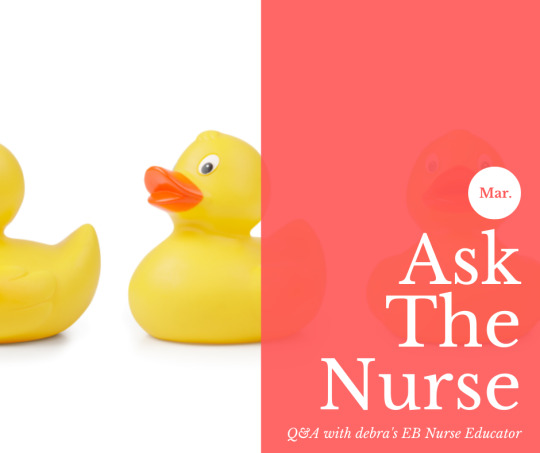
Each month, debra of America’s “Ask the Nurse” series will highlight a commonly asked question received by our Nurse Educator, Emily Griffith, BSN, RN. This month’s post focuses on Bathing. Let’s get started!
Question: Should I use Epsom salt or regular salt to soak my EB wounds, and will this help my wounds heal?
Answer: This is a great question. It is important to know that Epsom salt is not actually salt, it is made up of magnesium and sulfur. Epsom salt soak may be someone’s preference for bathing and for others, it may not.
Instead, you can add regular salt (sodium chloride) to your bath water to help reduce pain or the “stinging” feeling of open wounds in the water. You can use regular table salt or pool salt, which may be more economical to purchase for prolonged use.
Adding bleach or vinegar to bath water for infection prevention in those with extensive or chronic wounds is common practice in EB care. Colonization of bacteria can hinder wound healing even if there is not actual “infection” present. A diluted bleach or vinegar bath can reduce the amount of bacteria on the skin that could cause infections. Bleach and vinegar may be alternated with a bath but never used at the same time. You can, however, add salt to a bleach or vinegar bath.
For measurements and more information on how to prepare a bath, click here.
To read more commonly asked questions, click here.
If you have an EB care-related question for our EB Nurse Educator, please email: [email protected] or call toll-free at 866-DEBRA-76 (866-332-7276).
*The information provided herein is intended to educate the reader about certain medical conditions and certain possible treatments. It is not a substitute for examination, diagnosis, and medical care provided by a licensed and qualified health professional. If you believe you, your child, or someone you know, suffer from conditions described herein, please see your healthcare provider. Do not attempt to treat yourself, your child, or anyone else without proper medical supervision.
1 note
·
View note
Text
Ask the Nurse: Hospital Tips

Each month, debra of America’s “Ask the Nurse” series will highlight a commonly asked question received by our Nurse Educator, Emily Griffith, BSN, RN. This month’s post focuses on Hospital Tips. Let’s get started!
Question: When I go to the hospital, the EKG stickers always cause blisters or pull my skin off. How can I avoid this from happening?
Answer: The adhesive portion of the EKG leads are not necessary for the leads to work; it is simply there to adhere to the skin. In EB, we need to modify the way the EKG leads adhere to the skin if they are necessary for your care. You can cut off, or sometimes peel off, the adhesive backing on the EKG sticker. If there is remaining adhesive that feels like this will cause trauma, press the sticker onto a blanket or sheet over and over to make the backing less adhesive. Next, place the EKG leads in the appropriate locations and secure in place with EB-friendly tape or bandages such as Mepitac, Mepiform, or another Mepilex product available. Similar steps can be taken for the pulse oximeter such as cutting off the adhesive portion or pressing repeatedly against a blanket to remove adhesive. However, a pulse oximeter will read through some Mepilex products unlike the EKG leads. You can place Mepitac on the finger or toe first to protect the skin, then secure the pulse oximeter overtop the Mepitac so it is not directly touching the skin.
Click here for our Hospital Care Tip Sheet for more tips on EB precautions in the hospital setting and share with your healthcare providers.
To read more commonly asked questions, click here.
If you have an EB care-related question for our EB Nurse Educator, please email: [email protected] or call toll-free at 866-DEBRA-76 (866-332-7276).
*The information provided herein is intended to educate the reader about certain medical conditions and certain possible treatments. It is not a substitute for examination, diagnosis, and medical care provided by a licensed and qualified health professional. If you believe you, your child, or someone you know, suffer from conditions described herein, please see your healthcare provider. Do not attempt to treat yourself, your child, or anyone else without proper medical supervision.
0 notes
Text
Ask the Nurse: Face Masks

Each month, debra of America’s “Ask the Nurse” series will highlight a commonly asked question received by our Nurse Educator, Emily Griffith, BSN, RN. This month’s post focuses on face masks. Let’s get started!
Question: I have EB and I am required to wear a face mask all day for work, but I am worried this will cause painful blisters. How can I prevent this but still wear a mask?
Answer: Protecting your skin while wearing a mask is very important for those with EB. Here are a few things you can do to help: First, look for fabrics that are very soft like 100% cotton or bamboo material. Use protective bandages that can absorb moisture, such as Mepilex Lite, to prevent irritation from the mask. Mepilex Lite can be cut in a long strip over the bridge of the nose and cheeks and smaller strips for behind the ears.
Another option to relieve pressure and irritation from behind the ears is to use an Ear Saver. Ear Saver’s come in all different shapes and materials and are also helpful to adjust masks looser or tighter as needed. It is most important to practice good skin care for those that need to wear a mask for the majority of the day. Once you are able to safely remove your mask and clean your hands, gently wash your face with soap and water or a gentle cleanser to remove sweat or sebum that may have naturally built up throughout the day. Then apply a moisturizer to maintain hydrated, healthy skin.
To read more commonly asked questions, click here.
If you have an EB care-related question for our EB Nurse Educator, please email: [email protected] or call toll-free at 866-DEBRA-76 (866-332-7276).
Are you on EBconnect.org? Click here to watch Dr. Amy Paller’s informative video on Covid-19 & the EB Community.
*The information provided herein is intended to educate the reader about certain medical conditions and certain possible treatments. It is not a substitute for examination, diagnosis, and medical care provided by a licensed and qualified health professional. If you believe you, your child, or someone you know, suffer from conditions described herein, please see your healthcare provider. Do not attempt to treat yourself, your child, or anyone else without proper medical supervision.
0 notes
Text
Ask the Nurse: Nutrients
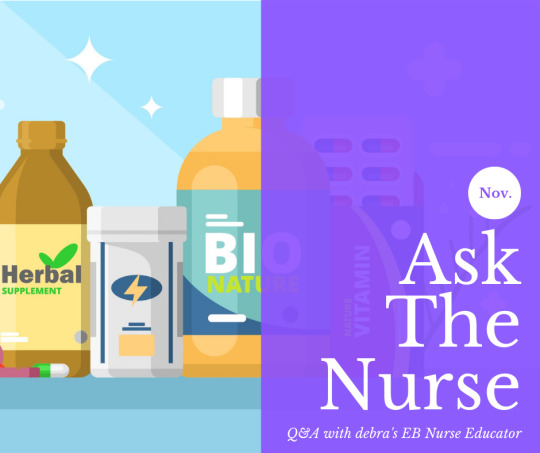
Each month, debra of America’s “Ask the Nurse” series will highlight a commonly asked question received by our Nurse Educator, Emily Griffith, BSN, RN. This month’s post focuses on nutrients. Let’s get started!
Question: I have EB and I recently had lab work done. Some of my levels were low, is this related to EB and how I can manage it?
Answer: Nutrients play an important role in the body and wound healing, which is why it’s necessary to monitor these nutrients with EB. If your physician recommends you take extra supplements or vitamins, it’s important to know how these supplements work and interact with your diet. These nutrients can also be managed through diet as well if extra supplementation is not recommended. Iron plays an important role in preventing anemia. Iron does not like zinc or calcium, but it does like vitamin C. So, if you take an iron pill, take it with a glass of OJ instead of a glass of milk to help boost iron absorption. If you want to boost iron absorption in your diet, then have some steak or chicken with potatoes or red peppers. Calcium is important, especially in EB, for bone and teeth health. Remember calcium and iron do not absorb well together so if you take both supplements, wait at least 2 hours after taking one to take the other. Calcium is best absorbed in the body when Vitamin D is present. In order to boost calcium and vitamin D in your diet, have some eggs with cheese for breakfast and salmon with spinach for dinner.
To read more commonly asked questions, click here.
If you have an EB care-related question for our EB Nurse Educator, please email: [email protected] or call toll-free at 866-DEBRA-76 (866-332-7276).
Are you on EBconnect.org? Click here to watch Registered Dietician Colleen Vicente's Virtual DCC Presentation on Nutritional Management of EB.
*The information provided herein is intended to educate the reader about certain medical conditions and certain possible treatments. It is not a substitute for examination, diagnosis, and medical care provided by a licensed and qualified health professional. If you believe you, your child, or someone you know, suffer from conditions described herein, please see your healthcare provider. Do not attempt to treat yourself, your child, or anyone else without proper medical supervision.
0 notes
Text
Ask the Nurse: Genetic Testing
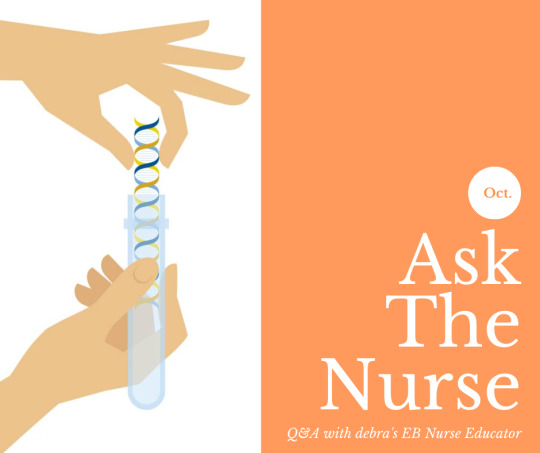
Each month, debra of America’s “Ask the Nurse” series will highlight a commonly asked question received by our Nurse Educator, Emily Griffith, BSN, RN. This month’s post focuses on genetic testing. Let’s get started!
Question: I just had a baby and the doctors think he has EB. Some people have suggested a biopsy but some have suggested genetic testing. What do these tests do and what do I learn from them?
Answer: Genetic testing is done by obtaining a blood sample and is now considered the standard for a diagnosis of EB. A small sample of blood is sent to a special lab where they can determine the specific disease-causing variant in the DNA. The results of genetic testing allow families and clinicians to provide appropriate management based on EB subtype. The results for genetic testing can take approximately 4-6 weeks and therefore a biopsy is often done in conjunction with genetic testing because the biopsy can produce results in just a few days. For a biopsy, a small sample of skin tissue is examined in a special lab to determine whether EB-associated proteins are lacking or absent. For those with milder symptoms of EB a biopsy may not be able to tell the difference between normal and EB skin. For this reason, genetic testing is recommended because of its accuracy and its ability to know how the EB variant was inherited which is important for families planning for future children.
To read more commonly asked questions, click here.
If you have an EB care-related question for our EB Nurse Educator, please email: [email protected] or call toll-free at 866-DEBRA-76 (866-332-7276).
*The information provided herein is intended to educate the reader about certain medical conditions and certain possible treatments. It is not a substitute for examination, diagnosis, and medical care provided by a licensed and qualified health professional. If you believe you, your child, or someone you know, suffer from conditions described herein, please see your healthcare provider. Do not attempt to treat yourself, your child, or anyone else without proper medical supervision.
0 notes
Text
Ask the Nurse: Honey

Each month, debra of America’s “Ask the Nurse” series will highlight a commonly asked question received by our Nurse Educator, Emily Griffith, BSN, RN. This month’s post focuses on honey. Let’s get started!
QUESTION: I heard honey is good for wound healing. What kind of honey should I use?
ANSWER: First and foremost, you should only use Medical grade honey on open wounds. Regular store-bought honey should NEVER be applied to the skin, especially in infants, as it may contain spores of Clostridium botulinum, which can cause infantile botulism (muscle paralysis). Medical grade honey can be prescribed by your physician and is often used for moderate to heavily draining wounds. Medihoney is a common brand used and can come in either a gel or different types of dressings. Medical grade honey is a beneficial tool to have for wound healing and infection reduction, especially when it comes to the overuse of topical antibiotics that patients can become de-sensitized to over time. Fun fact: you can store Medihoney gel or dressings in the refrigerator to provide a cooling effect for painful or itchy wounds.
To read more commonly asked questions, click here.
If you have an EB care-related question for our EB Nurse Educator, please email: [email protected] or call toll-free at 866-DEBRA-76 (866-332-7276).
*The information provided herein is intended to educate the reader about certain medical conditions and certain possible treatments. It is not a substitute for examination, diagnosis, and medical care provided by a licensed and qualified health professional. If you believe you, your child, or someone you know, suffer from conditions described herein, please see your healthcare provider. Do not attempt to treat yourself, your child, or anyone else without proper medical supervision.
0 notes
Text
Ask the Nurse: Esophageal Strictures

Each month, debra of America’s “Ask the Nurse” series will highlight a commonly asked question received by our Acting Nurse Educator, Shawn Tavani, R.N. This month’s post focuses on esophageal strictures. Let’s get started!
QUESTION: My 4 year old son who has Recessive Dystrophic EB (RDEB) is complaining of “food getting stuck in his throat” when he tries to swallow it. What is happening?
ANSWER: He most likely has an esophageal stricture.
Esophageal strictures are a serious complication of EB, with the RDEB subtype being the most prone to them. The esophagus is lined with the same tissue as the mucosa, which is also prone to blistering and sloughing and will form strictures of scar tissue where an area is affected. The act of eating can be difficult due to these issues with the mouth, throat and esophagus. Because we can’t see those areas with the naked eye, we have to depend on signs from those affected to know that they are having issues. Often, children will complain of it hurting when they swallow, will swallow hard, eating slower, and food may even get “stuck” at the area where the esophagus has narrowed from a stricture. They may even vomit the food item because it won’t go down the esophagus. If forceful enough, the lining of the esophagus may also be vomited up as well as blood.
To test for a stricture, a radiology test called a barium swallow can be performed. On the films, you can see the narrowed areas. Sometimes there is only one stricture, and sometimes there are more. A procedure called an esophageal dilatation can be done to “reopen” the esophagus so that food can once again, move down to the stomach to be digested. A person may need to have repeat esophageal dilatations throughout their life to maintain an open esophagus, but the frequency can vary from person to person.
To read more commonly asked questions, click here.
If you have an EB care-related question for our EB Nurse Educator, please email: [email protected] or call toll-free at 866-DEBRA-76 (866-332-7276)
*The information provided herein is intended to educate the reader about certain medical conditions and certain possible treatments. It is not a substitute for examination, diagnosis, and medical care provided by a licensed and qualified health professional. If you believe you, your child, or someone you know, suffer from conditions described herein, please see your healthcare provider. Do not attempt to treat yourself, your child, or anyone else without proper medical supervision.
1 note
·
View note
Text
Ask the Nurse: Corneal Abrasions

Each month, debra of America’s “Ask the Nurse” series will highlight a commonly asked question received by our Acting Nurse Educator, Shawn Tavani, R.N. This month’s post focuses on corneal abrasions. Let’s get started!
QUESTION: My daughter won’t open her eye and says it hurts. She also says light is bothersome. Is this a sign of a corneal abrasion? What do we do to treat it? How can we prevent it from happening in the future?
ANSWER: Yes, this sounds like she is experiencing a corneal abrasion.
Corneal abrasions are a common complication of Epidermolysis Bullosa and can occur in all types of EB. While mostly seen in DEB and JEB, there have been cases of eye involvement in EBS as well. Any rubbing, itching, or other trauma done to the eye can potentially cause an abrasion.
Prevention is key in reducing the occurrence of corneal abrasions. Using lubricating gel ointments and drops can reduce their occurrence for many people. Using the ointments or drops before bedtime is recommended and, if needed, they can be reapplied during the day, especially for people who tend to have chronic corneal abrasions. Protective contacts, applied by an ophthalmologist, can also be used in preventing corneal abrasions in those who are more prone to them as well. Because corneal abrasions can cause progressive scarring and reduced vision, prevention is key.
Corneal abrasions are extremely painful and often debilitating while the cornea heals. Because the eye becomes light sensitive, staying in a darkened room is often more comfortable for a person experiencing a corneal abrasion. The use of lubricating drops, pain relievers, and even prescription eye drops can aid in the healing of these abrasions. Occasionally, an ophthalmologist may also use a contact “bandage” to assist the healing process and make the eye more comfortable. Your ophthalmologist should be notified of an occurrence and a plan should be devised so that treatment can begin quickly to alleviate the discomfort and begin the healing process. A corneal abrasion will gradually resolve within a week and the person can continue their normal activities.
To read more commonly asked questions, click here.
If you have an EB care-related question for our EB Nurse Educator, please email: [email protected] or call toll-free at 866-DEBRA-76 (866-332-7276)
*The information provided herein is intended to educate the reader about certain medical conditions and certain possible treatments. It is not a substitute for examination, diagnosis, and medical care provided by a licensed and qualified health professional. If you believe you, your child, or someone you know, suffer from conditions described herein, please see your healthcare provider. Do not attempt to treat yourself, your child, or anyone else without proper medical supervision.
1 note
·
View note
Text
Ask the Nurse: Corns

Each month, debra of America’s “Ask the Nurse” series will highlight a commonly asked question received by our Acting Nurse Educator, Shawn Tavani, R.N. This month’s post focuses on corns. Let’s get started!
QUESTION: My daughter develops these hard, inflamed tender spots/bumps on her feet that are not callouses. They tend to reappear in the same location once they go away. It’s almost like they are embedded into her skin. I’m not sure what to do about them.
ANSWER: What you are most likely referring to are corns. Many EB patients complain about them but aren’t sure what they are or how to treat them. Corns appear at pressure points on the feet. Ill-fitting shoes and an abnormal gait can contribute to them forming. The type you are describing is hard corns. A hard corn is a patch of dead thickened skin with a central core that anchors into the foot...almost like a nail going into your foot. They can be extremely painful to walk on. Soaking the foot in warm water may soften the corn enough to remove but often the use of a topical such as an urea cream that a dermatologist can prescribe to soften the corn may work best.
To read more commonly asked questions, click here.
If you have an EB care-related question for our EB Nurse Educator, email: [email protected] or call toll-free at 866-DEBRA-76 (866-332-7276)
*The information provided herein is intended to educate the reader about certain medical conditions and certain possible treatments. It is not a substitute for examination, diagnosis, and medical care provided by a licensed and qualified health professional. If you believe you, your child, or someone you know, suffer from conditions described herein, please see your healthcare provider. Do not attempt to treat yourself, your child, or anyone else without proper medical supervision.
0 notes
Text
Ask the Nurse: Ointments

Each month, debra of America’s “Ask the Nurse” series will highlight a commonly asked question received by our Acting Nurse Educator, Shawn Tavani, R.N. This month’s post focuses on ointments. Let’s get started!
QUESTION: I am trying to figure out what topicals/ointments I should be using on my son’s wounds, but I see a wide variety of types being used. What topicals work the best?
ANSWER: It can be a bit overwhelming when discussing what topicals and ointments work best for basic wound healing in EB. And there is not one “best” answer as to how someone may respond to a particular topical/ointment. It can differ among individuals and the wounds themselves. There are many different scenarios that can require a change in topicals as well. The basic goal of using ointments is to provide a moist environment in which the wound will heal. The most popular ointments/topicals that we see being used by the community are Virgin Unfiltered Coconut Oil, Aquaphor and hydrogels to add moisture. Sometimes we encounter wounds that are draining heavily, and topical zinc is used to attempt to reduce the moisture of an overly wet wound. Many times, we will see the use of an ointment and zinc together in these cases, so the wound does not become too dry. In some cases, if a wound isn’t healing, such as due to a development of biofilm, it may require the use of a honey-based ointment, a debriding agent or antibiotic.
Much of knowing what works best for an individual comes through trials of different products and is determined by how a wound is healing vs. not healing. Always check to make sure a product is safe to use on an open wound and avoid lotions that contain alcohol.
To read more commonly asked questions, click here.
If you have an EB care-related question for our EB Nurse Educator, email: [email protected] or call toll-free at 866-DEBRA-76 (866-332-7276)
*The information provided herein is intended to educate the reader about certain medical conditions and certain possible treatments. It is not a substitute for examination, diagnosis, and medical care provided by a licensed and qualified health professional. If you believe you, your child, or someone you know, suffer from conditions described herein, please see your healthcare provider. Do not attempt to treat yourself, your child, or anyone else without proper medical supervision.
0 notes
Text
Ask the Nurse: Aquaphor

Each month, debra of America’s “Ask the Nurse” series will highlight a commonly asked question received by our EB Nurse Educator. This month’s post focuses on Aquaphor. Let’s get started!
QUESTION: Can you tell me about the program Aquaphor offers to receive jars of it for free?
ANSWER: Aquaphor is a non-medicated topical that when used alone, or on a dressing, can help maintain a moist environment on the wound bed. When used on dressings, it helps to prevent sticking to the wound. Beiersdorf, the maker of Aquaphor, does have a program that provides jars to patients at no cost to them. Families who would like to receive free Aquaphor may call their customer service line at 1-800-227-4703 to register for this service. A letter from you/your child’s physician is required, and it should state the patient’s name, contact information, diagnosis & treatment plan, and that Aquaphor is a medically necessary part of the patient's care. This letter needs to be emailed or faxed to them (their customer service rep will provide you this information). Once you are registered, patients can typically request a new case every 3 months. This program is available to U.S.residents only.
To read more commonly asked questions, click here.
If you have an EB care-related question for our EB Nurse Educator, please email: [email protected] or call toll-free at 866-DEBRA-76 (866-332-7276)
*The information provided herein is intended to educate the reader about certain medical conditions and certain possible treatments. It is not a substitute for examination, diagnosis, and medical care provided by a licensed and qualified health professional. If you believe you, your child, or someone you know, suffer from conditions described herein, please see your healthcare provider. Do not attempt to treat yourself, your child, or anyone else without proper medical supervision.
2 notes
·
View notes
Text
Ask the Nurse: PGD

Each month, debra of America’s “Ask the Nurse” series will highlight a commonly asked question received by our Acting Nurse Educator, Shawn Tavani, R.N. This month’s post focuses on Preimplantation Genetic Diagnosis (PGD). Let’s get started!
QUESTION: I have been thinking about expanding my family, and have heard that PGD is an option, but I don’t really know what this is. What exactly is PGD and what is involved?
ANSWER: PGD stands for Preimplantation Genetic Diagnosis, and it is a reproductive technology used along with IVF (in vitro fertilization) that essentially, in the case of EB, allows physicians to detect the genetic disease in early formed embryos before implantation. This can increase the chances of having a child free of EB. In cases of EB, there are some preliminary steps that need to be taken before PGD can be performed. Having genetic test results from the person who has EB in your family is the initial step in this process.
Knowing what genetic mutations occur in the family allows testing for those specific known mutations. Once this is known, for PGD, the mother would start hormone treatments to increase the number of eggs available during her monthly cycle. These mature eggs are removed surgically from the ovaries and fertilized with the father’s sperm.
Once the embryo is large enough (usually day 5 after fertilization), the specialists can remove a couple of cells to test. Those embryos that are not affected with EB, then can be implanted. With recessive cases of EB, the embryos can be tested and result in having both mutations, one mutation (a carrier), or no mutations (no EB). With dominant mutations, results will be either that the mutation is present or isn’t present.
Once the embryos have been tested and implanted, your physician will follow you closely to monitor if this implantation is successful and pregnancy occurs. If successful, the physician will monitor you throughout pregnancy.
When looking at a reproductive specialty practice, it is often good practice to interview the specialist that will be involved in your care and ask about their success rates so that you can feel confident in the care you will receive. It is also known that PGD is not 100% guaranteed but 98-99% accurate. There are several factors that can contribute to this including human error, technological limitations, and the possibility of mosaicism.
There are many EB families who have expanded their families successfully with PGD but, unfortunately it is often cost prohibitive for many and may not be totally covered by insurance. For those families, there may be other options available. For any questions concerning PGD or other options, we are available to discuss and you may contact us at your convenience.
To read more commonly asked questions, click here.
If you have an EB care-related question for our EB Nurse Educator, please email: [email protected] or call toll-free at 866-DEBRA-76 (866-332-7276)
*The information provided herein is intended to educate the reader about certain medical conditions and certain possible treatments. It is not a substitute for examination, diagnosis, and medical care provided by a licensed and qualified health professional. If you believe you, your child, or someone you know, suffer from conditions described herein, please see your healthcare provider. Do not attempt to treat yourself, your child, or anyone else without proper medical supervision.
#AskTheNurse#EBNurseEducator#EpidermolysisBullosa#WeFightEB#EBawareness#PGD#Preimplantation Genetic Diagnosis
1 note
·
View note
Text
Ask the Nurse: Pioneering Skin Graft Procedure

Each month, debra of America’s “Ask the Nurse” series will highlight a commonly asked question received by our Acting Nurse Educator, Shawn Tavani, R.N. This month’s post focuses on the revolutionary skin graft procedure that was recently covered in The Atlantic, the New York Times, NPR, and other major news sources. Let’s get started!
QUESTION: I recently saw a new piece where a little boy in Germany had much of his skin replaced with gene therapy altered skin grafts. I would like to know more and see about having this done for my child. How do I get this treatment for him?
ANSWER: This is incredible and exciting news in our world. The experimental skin grafting procedure was performed on one individual with Junctional Epidermolysis Bullosa, and is currently not a research trial open for enrollment. The results of this procedure serve as a great advancement in the scientific world, and hopefully hold promise for the future of EB Research. Mike Jaega, President of DEBRA International, released a statement regarding the particular trial and what may happen next:
“This is without doubt an incredibly interesting trial and a positive step forward that has had remarkable results. There has been a huge amount of interest and positive awareness since this story broke into the public domain. As someone with EB, I think it should be noted that this was a trial with a Junctional EB patient and the young man had to have extensive operations and monitoring. The results of this trial are an enormous step for those suffering from Junctional EB, but that doesn’t automatically mean it will transfer to other types and subtypes of EB. We need to support the next step in this process to explore if or how this trial can help other types of EB. The fantastic thing is that all these trials are a step in the right direction; one monumental step in finding viable treatments for EB around the world. It’s a hugely exciting time for research but we must keep our feet on the ground while we continue to reach for the stars. Gene and cell therapy trials, and even innovative ideas producing new dressings and appliances to help people with EB, are all important." Click here to continue reading.
DEBRA International is a consortium of 56 national debra organizations worldwide. Brett Kopelan, Executive Director of debra of America, serves on the Executive Committee of the DEBRA International Board of Directors.
To read more commonly asked questions, click here.
If you have an EB care-related question for our EB Nurse Educator, please email: [email protected] or call toll-free at 866-DEBRA-76 (866-332-7276)
*The information provided herein is intended to educate the reader about certain medical conditions and certain possible treatments. It is not a substitute for examination, diagnosis, and medical care provided by a licensed and qualified health professional. If you believe you, your child, or someone you know, suffer from conditions described herein, please see your healthcare provider. Do not attempt to treat yourself, your child, or anyone else without proper medical supervision.
0 notes